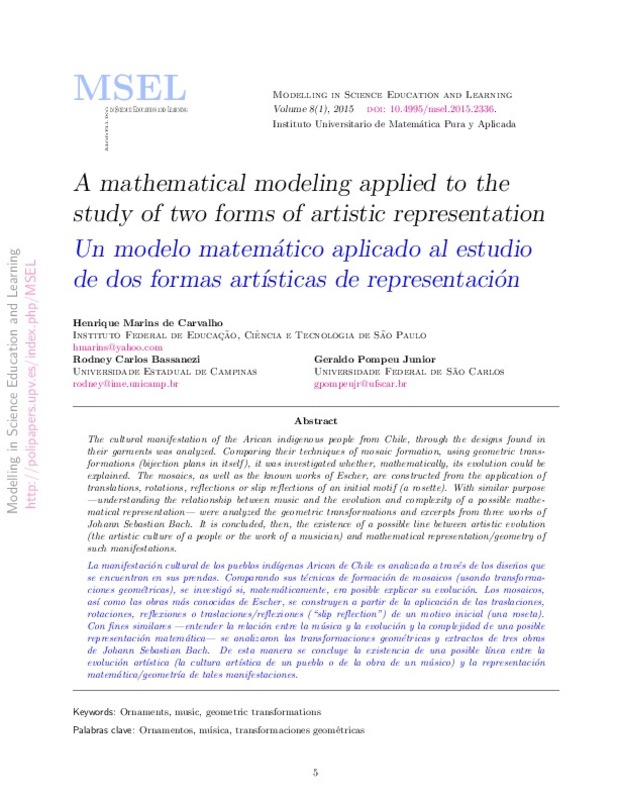JavaScript is disabled for your browser. Some features of this site may not work without it.
Buscar en RiuNet
Listar
Mi cuenta
Estadísticas
Ayuda RiuNet
Admin. UPV
A mathematical modeling applied to the study of two forms of artistic representation
Mostrar el registro sencillo del ítem
Ficheros en el ítem
| dc.contributor.author | Marins de Carvalho, Henrique
|
es_ES |
| dc.contributor.author | Bassanezi, Rodney Carlos
|
es_ES |
| dc.contributor.author | Pompeu Junior, Geraldo
|
es_ES |
| dc.date.accessioned | 2016-09-16T12:50:21Z | |
| dc.date.available | 2016-09-16T12:50:21Z | |
| dc.date.issued | 2015-01-13 | |
| dc.identifier.uri | http://hdl.handle.net/10251/70009 | |
| dc.description.abstract | [EN] The cultural manifestation of the Arican indigenous people from Chile, through the designs found in their garments was analyzed. Comparing their techniques of mosaic formation, using geometric transformations (bijection plans in itself ), it was investigated whether, mathematically, its evolution could be explained. The mosaics, as well as the known works of Escher, are constructed from the application of translations, rotations, reflections or slip reflections of an initial motif (a rosette). With similar purpose —understanding the relationship between music and the evolution and complexity of a possible mathematical representation— were analyzed the geometric transformations and excerpts from three works of Johann Sebastian Bach. It is concluded, then, the existence of a possible line between artistic evolution (the artistic culture of a people or the work of a musician) and mathematical representation/geometry of such manifestations. | es_ES |
| dc.description.abstract | [ES] La manifestacion cultural de los pueblos indgenas Arican de Chile es analizada a traves de los diseños que se encuentran en sus prendas. Comparando sus tecnicas de formacion de mosaicos (usando transformaciones geometricas), se investigo si, matematicamente, era posible explicar su evolucion. Los mosaicos, as como las obras mas conocidas de Escher, se construyen a partir de la aplicacion de las traslaciones, rotaciones, re exiones o traslaciones/re exiones (\slip re ection") de un motivo inicial (una roseta). Con nes similares |entender la relacion entre la musica y la evolucion y la complejidad de una posible representacion matematica| se analizaron las transformaciones geometricas y extractos de tres obras de Johann Sebastian Bach. De esta manera se concluye la existencia de una posible lnea entre la evolucion artstica (la cultura artstica de un pueblo o de la obra de un musico) y la representacion matematica/geometra de tales manifestaciones. | es_ES |
| dc.language | Inglés | es_ES |
| dc.publisher | Universitat Politècnica de València | |
| dc.relation.ispartof | Modelling in Science Education and Learning | |
| dc.rights | Reconocimiento - No comercial (by-nc) | es_ES |
| dc.subject | Ornaments | es_ES |
| dc.subject | Music | es_ES |
| dc.subject | Mathematical Model | es_ES |
| dc.subject | Geometric transformations | es_ES |
| dc.subject | Ornamentos | es_ES |
| dc.subject | Transformaciones geometricas | es_ES |
| dc.subject | Música | es_ES |
| dc.subject | Manifestaciones artísticas | es_ES |
| dc.subject | Arte | es_ES |
| dc.subject | Modelos matemáticos | es_ES |
| dc.title | A mathematical modeling applied to the study of two forms of artistic representation | es_ES |
| dc.title.alternative | Un modelo matemático aplicado al estudio de dos formas artísticas de representación | es_ES |
| dc.type | Artículo | es_ES |
| dc.date.updated | 2016-09-16T10:27:37Z | |
| dc.identifier.doi | 10.4995/msel.2015.2336 | |
| dc.rights.accessRights | Abierto | es_ES |
| dc.description.bibliographicCitation | Marins De Carvalho, H.; Bassanezi, RC.; Pompeu Junior, G. (2015). A mathematical modeling applied to the study of two forms of artistic representation. Modelling in Science Education and Learning. 8(1):5-21. https://doi.org/10.4995/msel.2015.2336 | es_ES |
| dc.description.accrualMethod | SWORD | es_ES |
| dc.relation.publisherversion | https://doi.org/10.4995/msel.2015.2336 | es_ES |
| dc.description.upvformatpinicio | 5 | es_ES |
| dc.description.upvformatpfin | 21 | es_ES |
| dc.type.version | info:eu-repo/semantics/publishedVersion | es_ES |
| dc.description.volume | 8 | |
| dc.description.issue | 1 | |
| dc.identifier.eissn | 1988-3145 | |
| dc.description.references | Abdounur, O. J. (2003). Matemática e Música: O pensamento analógico na construção de significados. São Paulo, Brasil: Escrituras Editora. | es_ES |
| dc.description.references | Bach, A. M. (1938). Bach. São Paulo, Brasil: Cultura Brasileira. | es_ES |
| dc.description.references | Bassanezi, R. C. (1988). A Matemática dos Ornamentos e A Cultura Arica. Revista de Ensino de Ciências (FUNBEC), 21 (5), 39-45. | es_ES |
| dc.description.references | Cruz, M. N. (2005). Desenvolvimento Cognitivo em Vygotsky: entre os ideais da matemática e a harmonia da imaginação. In: 28ª Reunião Anual da Anped, Caxambú/MG, Brasil, 1-15. | es_ES |
| dc.description.references | Horta, L. P. (Ed.). (1985). Dicionário de Música. Rio de Janeiro, Brasil: Zahar Editores. | es_ES |
| dc.description.references | NCTM (2000). Principles and Standards for School Mathematics. Reston, Canada: National Council of Teachers of Mathematics. | es_ES |
| dc.description.references | Sadie, S. (1994). Dicionário Grove de Música (Edição Concisa). Rio de Janeiro, Brasil: Zahar Editores. | es_ES |
| dc.description.references | Scimemi, B. (1997). Contraponto Musical e Transformações Geométricas. Lettera Matemática Pristem, 27-28. Itália: Springer. | es_ES |








